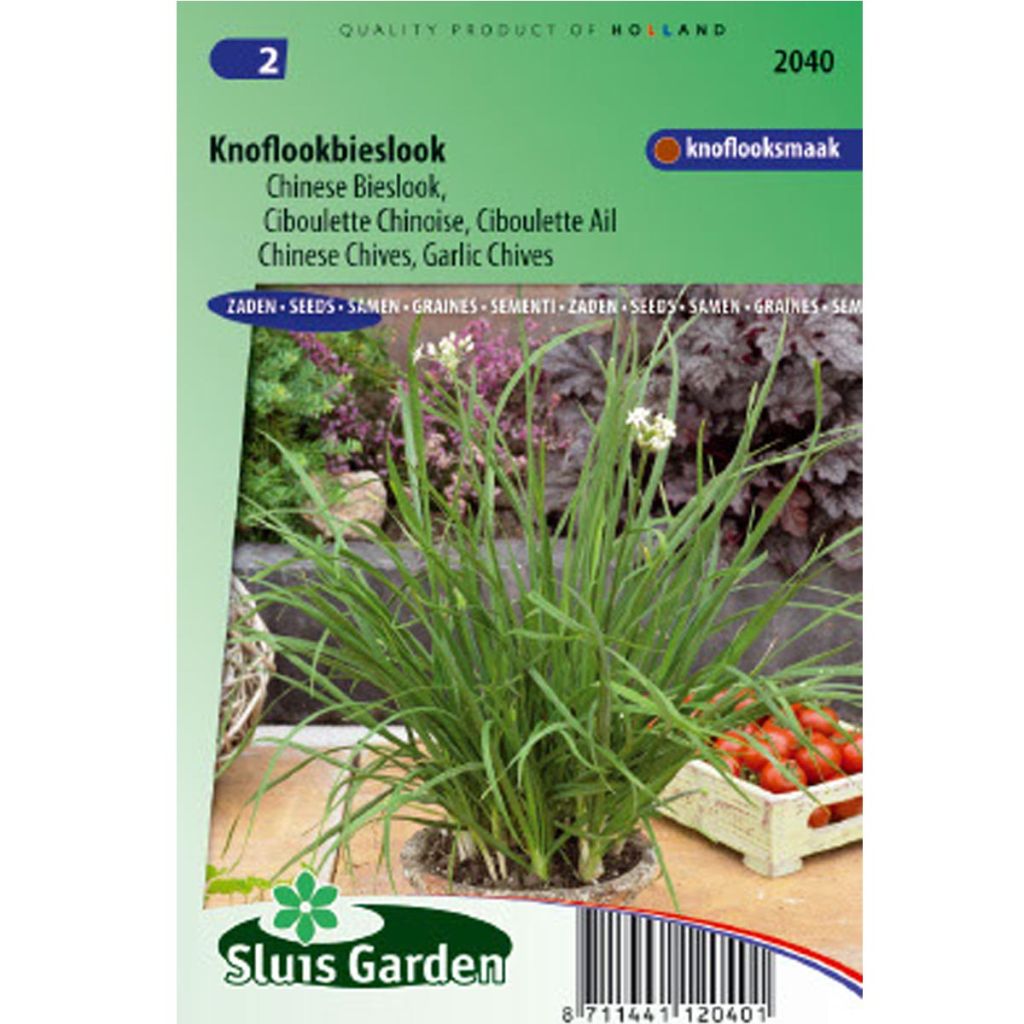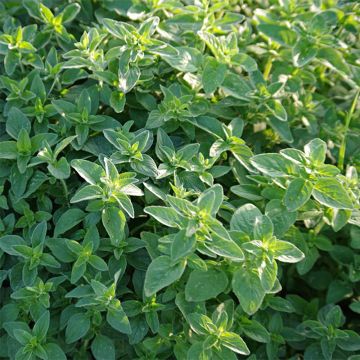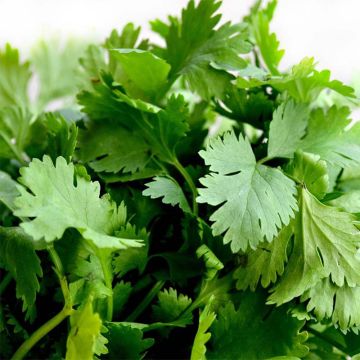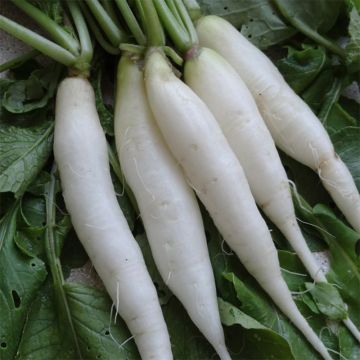

Chinese Chives - Allium tuberosum
Chinese Chives - Allium tuberosum
Allium tuberosum
Garlic Chives, Chinese Chives, Oriental Garlic, Chinese Leek
Nothing to lift.
Eugenie, 20/09/2020
This item cannot be shipped to the selected country
Dispatch by letter from €3.90
More information
Schedule delivery date,
and select date in basket
This plant carries a 6 months recovery warranty
More information
We guarantee the quality of our plants for a full growing cycle, and will replace at our expense any plant that fails to recover under normal climatic and planting conditions.
Seed-only orders are dispatched by sealed envelope. The delivery charge for seed-only orders is €3.90.
Description
Allium tuberosum, also known as Chinese chives or garlic chives, is a variety of plant that is similar to spring onion. Its flat leaves have a mild garlic flavour. It can be enjoyed raw, finely chopped in salads, or cooked in omelettes and soups. The white star-shaped flowers can also be consumed. Sow the seeds from February to May. Harvest from late May to September.
Chinese chives are a tasty perennial aromatic plant. They belong to the same family as garlic, onion, and shallot. They are like the sister of chives, but in an extra-large version, with a clumping habit (reaching a height of up to 70cm (28in)) and hollow, cylindrical leaves. They should only be grown for two or three years, as they tend to become less productive after that.
Their mild, garlicky flavour is suitable for many dishes, adding flavour to salads and soups, for example.
Harvest: chives can be harvested from late spring to autumn, simply by cutting the stems at the base of the clump with scissors. Regular harvests stimulate the renewal of the foliage.
Storage: chives can be stored in a refrigerator for a few days, or dried or frozen for a few months. However, to fully enjoy their fragrance, it is best to consume them freshly picked.
Gardener's tip: mulch the soil from May with successive thin layers of grass clippings, if possible mixed with dead leaves. This protection keeps the soil moist and reduces weeding.
Report an error about the product description
Harvest
Plant habit
Foliage
Botanical data
Allium
tuberosum
Alliaceae
Garlic Chives, Chinese Chives, Oriental Garlic, Chinese Leek
Cultivar or hybrid
Perennial
Other Herb seeds
Planting and care
Sowing
Germination occurs at a temperature of around 18°C (64.4°F). It takes between 20 and 25 days for the seedlings to emerge.
Sowing can be done either under cover or in open ground.
Sow from the end of February, in a cool place at home or in a greenhouse. Use a tray with drainage holes and fill it with special sowing compost. Sow the seeds at a depth of 2 to 3mm, spacing them 5 to 7cm (2 to 3in) apart. Water with a very fine spray. When your young plants have 4 leaves, transplant 3 or 4 plants into pots and place them in the garden in autumn or the following spring.
Sowing in open ground is done later, usually around mid-May. Sow in the same way as sowing under cover, ensuring the soil is warm.
When planting in their final location, leave 40cm (16in) between each row and 20cm (8in) between each plant in the row. We recommend planting them in different areas of the garden: in the sun for spring harvest and in partial shade for summer harvest.
Cultivation
Chives thrive in the sun or partial shade, in moderately rich soil. If compost is needed, it should be applied in autumn, in the form of well-rotted compost (no manure). Loosen the soil, and then rake in the compost to a depth of 5cm (2in). This plant is quite tolerant of soil pH, and will thrive if it is between 5.5 and 7.5.
Multiplication of chives is very easy and can be done by dividing clumps from March to May and from September to October.
Seedlings
Care
Intended location
-
, onOrder confirmed
Reply from on Promesse de fleurs
Vegetable seeds
Haven't found what you were looking for?
Hardiness is the lowest winter temperature a plant can endure without suffering serious damage or even dying. However, hardiness is affected by location (a sheltered area, such as a patio), protection (winter cover) and soil type (hardiness is improved by well-drained soil).

Photo Sharing Terms & Conditions
In order to encourage gardeners to interact and share their experiences, Promesse de fleurs offers various media enabling content to be uploaded onto its Site - in particular via the ‘Photo sharing’ module.
The User agrees to refrain from:
- Posting any content that is illegal, prejudicial, insulting, racist, inciteful to hatred, revisionist, contrary to public decency, that infringes on privacy or on the privacy rights of third parties, in particular the publicity rights of persons and goods, intellectual property rights, or the right to privacy.
- Submitting content on behalf of a third party;
- Impersonate the identity of a third party and/or publish any personal information about a third party;
In general, the User undertakes to refrain from any unethical behaviour.
All Content (in particular text, comments, files, images, photos, videos, creative works, etc.), which may be subject to property or intellectual property rights, image or other private rights, shall remain the property of the User, subject to the limited rights granted by the terms of the licence granted by Promesse de fleurs as stated below. Users are at liberty to publish or not to publish such Content on the Site, notably via the ‘Photo Sharing’ facility, and accept that this Content shall be made public and freely accessible, notably on the Internet.
Users further acknowledge, undertake to have ,and guarantee that they hold all necessary rights and permissions to publish such material on the Site, in particular with regard to the legislation in force pertaining to any privacy, property, intellectual property, image, or contractual rights, or rights of any other nature. By publishing such Content on the Site, Users acknowledge accepting full liability as publishers of the Content within the meaning of the law, and grant Promesse de fleurs, free of charge, an inclusive, worldwide licence for the said Content for the entire duration of its publication, including all reproduction, representation, up/downloading, displaying, performing, transmission, and storage rights.
Users also grant permission for their name to be linked to the Content and accept that this link may not always be made available.
By engaging in posting material, Users consent to their Content becoming automatically accessible on the Internet, in particular on other sites and/or blogs and/or web pages of the Promesse de fleurs site, including in particular social pages and the Promesse de fleurs catalogue.
Users may secure the removal of entrusted content free of charge by issuing a simple request via our contact form.
The flowering period indicated on our website applies to countries and regions located in USDA zone 8 (France, the United Kingdom, Ireland, the Netherlands, etc.)
It will vary according to where you live:
- In zones 9 to 10 (Italy, Spain, Greece, etc.), flowering will occur about 2 to 4 weeks earlier.
- In zones 6 to 7 (Germany, Poland, Slovenia, and lower mountainous regions), flowering will be delayed by 2 to 3 weeks.
- In zone 5 (Central Europe, Scandinavia), blooming will be delayed by 3 to 5 weeks.
In temperate climates, pruning of spring-flowering shrubs (forsythia, spireas, etc.) should be done just after flowering.
Pruning of summer-flowering shrubs (Indian Lilac, Perovskia, etc.) can be done in winter or spring.
In cold regions as well as with frost-sensitive plants, avoid pruning too early when severe frosts may still occur.
The planting period indicated on our website applies to countries and regions located in USDA zone 8 (France, United Kingdom, Ireland, Netherlands).
It will vary according to where you live:
- In Mediterranean zones (Marseille, Madrid, Milan, etc.), autumn and winter are the best planting periods.
- In continental zones (Strasbourg, Munich, Vienna, etc.), delay planting by 2 to 3 weeks in spring and bring it forward by 2 to 4 weeks in autumn.
- In mountainous regions (the Alps, Pyrenees, Carpathians, etc.), it is best to plant in late spring (May-June) or late summer (August-September).
The harvesting period indicated on our website applies to countries and regions in USDA zone 8 (France, England, Ireland, the Netherlands).
In colder areas (Scandinavia, Poland, Austria...) fruit and vegetable harvests are likely to be delayed by 3-4 weeks.
In warmer areas (Italy, Spain, Greece, etc.), harvesting will probably take place earlier, depending on weather conditions.
The sowing periods indicated on our website apply to countries and regions within USDA Zone 8 (France, UK, Ireland, Netherlands).
In colder areas (Scandinavia, Poland, Austria...), delay any outdoor sowing by 3-4 weeks, or sow under glass.
In warmer climes (Italy, Spain, Greece, etc.), bring outdoor sowing forward by a few weeks.

























































